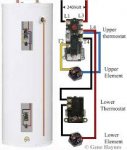Stevenfyeager
Senior Member
- Location
- United States, Indiana
- Occupation
- electrical contractor
My customer just installed a 36 gal water heater. The label says upper and lower elements are both 4500 w. But it says "total watts connected : 4500 watts" I've always wondered how two 4500 w elements can be only 4500 w connected, I obviously don't understand how they work. ( I always install a 30 amp breaker and #10 wire. ) The existing circuit was #12 wire on a 20 amp breaker. I replaced the #12 with #10. But when I divide 4500 by 240 v, I get 18.75 amps. So is the 20 amp breaker ok ? Thank you !!


